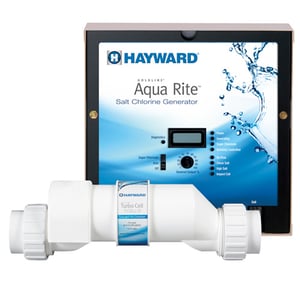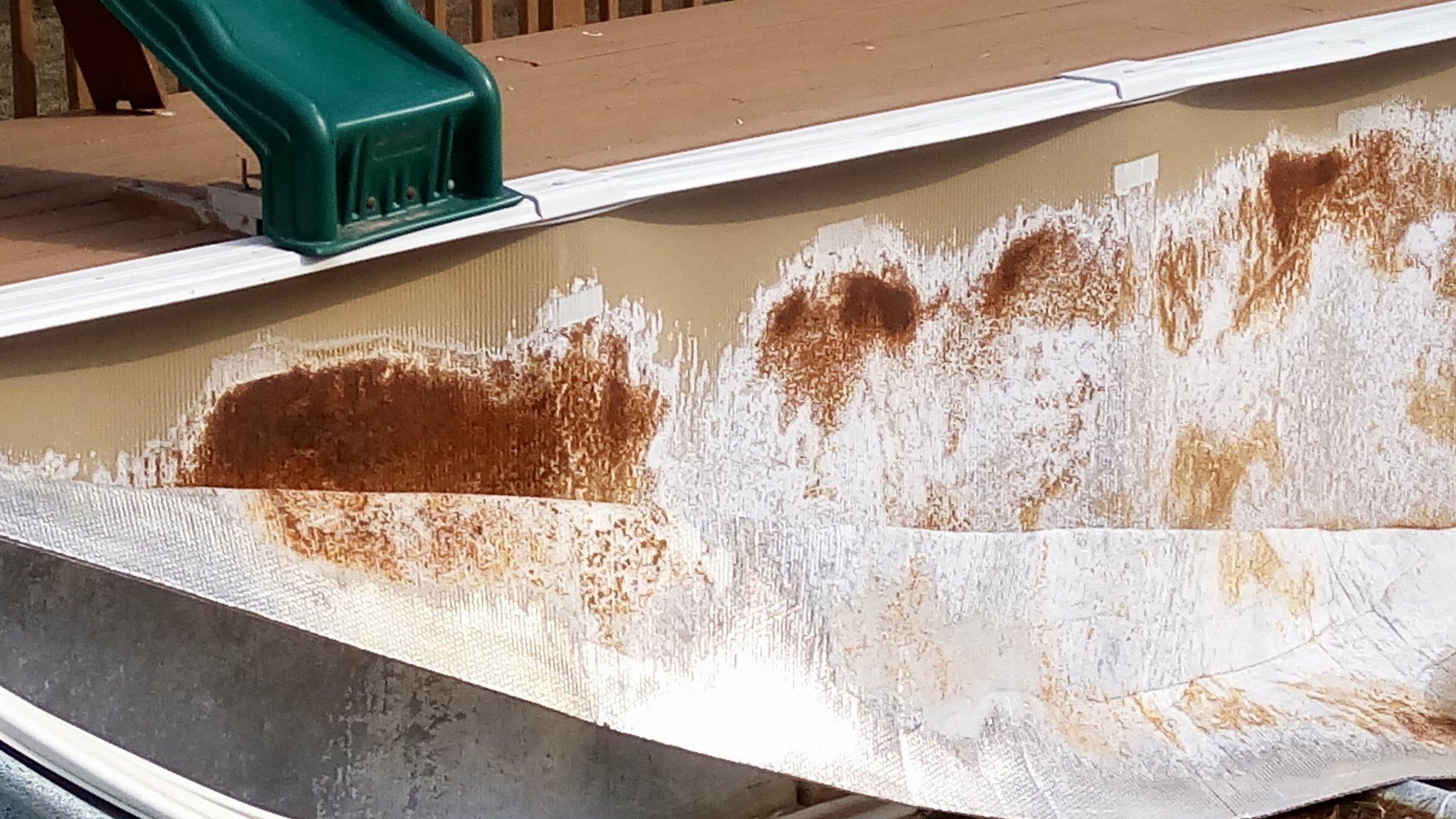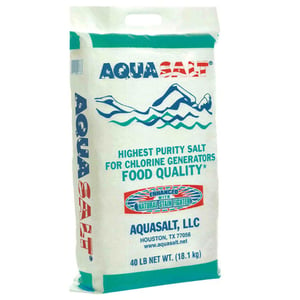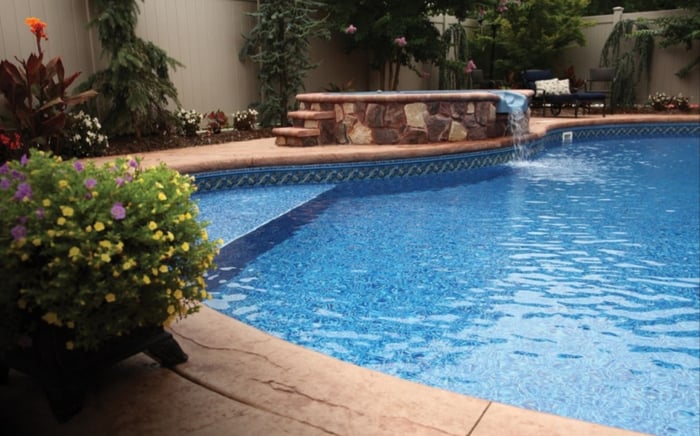Perhaps you have a swimming pool, and it already uses a traditional chlorine sanitizing system to keep your pool water clean which is fine and all... but you've heard of all the benefits of saltwater pool systems and want to change over to the salty side.
Luckily, it turns out converting a chlorine pool to a saltwater pool is not only a fairly simple process, but relatively inexpensive as well! In this article, we'll cover the basics of switching to saltwater and how you can easily do it yourself (or hire someone to do it for you).
Why Switch to a Saltwater Pool?
Many of the negatives from chlorine pools, such as the "chlorine smell," skin and eye irritation, and the constant maintenance of chlorine levels don't even exist with salt pools. And while you will still check the chemicals regularly, you'll typically make less frequent adjustments since you'll see fewer peaks and valleys in chemical and pH levels. With of fewer spikes in chlorine, irritation of eyes and skin is less common, and the pool's water is gentler on hair and clothing. Water in a saltwater system also tends to feel "softer" and more luxurious to swim in.
And even though they cost more upfront, saltwater pools save money in the long-term due to less maintenance and chemical use.
What Is a Saltwater Pool?
One of the biggest misconceptions about a saltwater pool is that they don't use chlorine to keep the water clean. This is not the case, as chlorine is still used as a sanitizing agent. The difference is that with a saltwater pool the salt works with a salt cell to produce the chlorine for you as it is needed. This not only means you won't have to handle liquid chlorine or chlorine tablets, but your pool will generally have lower chlorine levels than it would with a traditional system.
As the chlorine is regulated through your salt cell and its connected automation system, your pool will not experience the constant seesaw of spikes and drops commonly associated with traditional chlorine pools. For a more detailed comparison, check out our breakdown of chlorine vs. saltwater vs. mineral pools.
Does a Saltwater Pool Taste Like the Ocean?While you may notice a hint of salt in the water, what you experience will not be anything like the salt in the ocean. A standard saltwater pool has a salt concentration of about 3,000 parts per million (ppm) which may sound like a lot until you compare it to the roughly 35,000 ppm that's found in the ocean!
|
How to Convert Your Pool to Saltwater
Have you decided to go ahead and make switch to a saltwater pool? As mentioned, converting your pool from chlorine to saltwater is a fairly simple process. With the right materials and proper steps, you'll be swimming in your new saltwater swimming pool in no time!
What Materials are Needed to Convert to a Saltwater Pool?
As neat as it would be to just add table salt to your water, to convert your pool to saltwater, first you'll need a few necessary components (of which table salt is not among them). You'll need the following:
You'll also need to be sure to have proper electricity available to power the system.
Choosing the Right Salt Chlorinator System for Your Pool
The main component of a saltwater pool system is the chlorinator. A salt chlorinator system consists of two major parts: the salt cell and the control board. The salt cell is where the electrolysis takes place that converts the salt in your pool's water to chlorine. The control board controls how much chlorine is generated.
Which system you choose is largely a matter of preference and budget, as some systems come with considerably more features than others. But what is most important is that you choose a salt system that is rated for your pool's water volume. The most common ratings are 15,000 gallons, 25,000 gallons, and 40,000 gallons. You'll just want to choose a system that meets or exceeds your pool's water volume, and you should be in good shape. (Don't know your pool's water volume? Use our pool water volume calculator.)
The Importance of a Sacrificial Anode
Ask anyone who lives near an ocean, salt water is corrosive! Scuba divers "Ooo" and "Ahh" over underwater treasures left eaten away by the sea while boaters will spend hours washing off of their favorite outdoor toys to keep them from being ruined by the harsh salty water. All metal is at risk of salt damage. This means that over time the salt in your swimming pool may seemingly attack the metal components of your pool. A sacrificial anode is a little part with a big job! It works as a way to protect against this by "sacrificing" itself to bear the brunt of any system corrosion. Essentially the salt water will eat the anode first instead of your pool's other metal components.
The anode is added to your plumbing (or can even be added as a skimmer insert) and connects via a wire to whatever piece of metal equipment you'd like to protect. The corrosion is then redirected to an inexpensive zinc anode, which can be easily replaced every few years. This will help keep your pool rust-free.

Don't Forget the Salt!

One major piece of a saltwater system that's easy to forget when you're planning your system is the salt itself. We recommend salt specifically formulated for use in swimming pools, as other salts such as rock salt and solar salt may add unwanted staining or sediment to your pool. Using high-purity pool salt will help avoid any of these potential side-effects.
BONUS: You know what goes really well with salt? PEPPER!
PEPPER® is the perfect pairing for salt water pools. It's a special blend of select ingredients which is formulated to work specifically with the unique demands of salt water pools.
What does that mean? Adding PEPPER® to your pool will enhance water quality, protect your pool equipment, and reduce overall maintenance. When used routinely PEPPER® will increase the salt cell life and performance, limit pH fluctuations, and prevent scale buildup while virtually eliminating the need for balancers and other remedial products. Basically that's a lot of words to say, when you use PEPPER®, it's like you're adding all of these (only in one easy to use, safe mix that you add twice a month):
- Unmatched water quality
- Reduce your maintenance time by 75%
- Maximize cell life
- Virtually eliminate water balance confusion
- SIMPLE, use twice per month
Saltwater Preparation Steps
Before you start installing any of the components for your new saltwater system, first you need to balance your pool water according to your installation manual specifications. Note do not drain the pool. The only time you should drain your swimming pool is when you are replacing the liner.
Once your levels are balanced, add the required amount of pool-grade salt to achieve the desired concentration. The amount of salt needed will be based on the volume of water in your pool. To add the salt, simply broadcast it across the pool's surface and give it time to dissolve (this may take up to 24 hours).

Installing the Components
Now that your levels are balanced and the salt has been added (your PEPPER® too), it's time to add your chlorination system. Your chlorinator should come with its own set of instructions, but the general process should be along these lines:
- Mount the chlorinator controller near your pool equipment pad, ideally on a wall.
- Wire the chlorinator controller for power according to the manual specifications.
- Install the salt cell into the pool plumbing after the filter.
- Note: The salt cell should be the final piece of equipment in your pool plumbing before the water returns to the pool.
- Add a sacrificial anode to your plumbing lines.
- Connect the salt cell to the control board.
- Turn on your pool pump and check for any leaks. Let it run for several hours to circulate the water and dissolve any undissolved salt.
- Finally, turn on the power to your new salt chlorinator and enjoy your saltwater pool!
Here are some additional pool maintenance resources to help keep your pool crystal clear!
- Finally! An Easy Solution to Pool Maintenance
- The perfect solution for your saltwater pool: Pepper!
- Chlorine vs. Saltwater vs. Mineral System Pools: Pros and Cons
- How to clear a murky green pool fast with Revive
- How to Maintain a Saltwater Swimming Pool
- How To Troubleshoot Problems with Your Salt Cell
- Type of Salt to Use with a Swimming Pool Salt System
- Saltwater Above Ground Pools: A Buyer’s Guide
- How To Clean the Salt Cell on Your Saltwater Swimming Pool
- What is the Benefit of Switching to Salt Water?





-2-2.jpeg?width=2988&name=WON%20Marty%20Sheedy%201%20(2)-2-2.jpeg)




